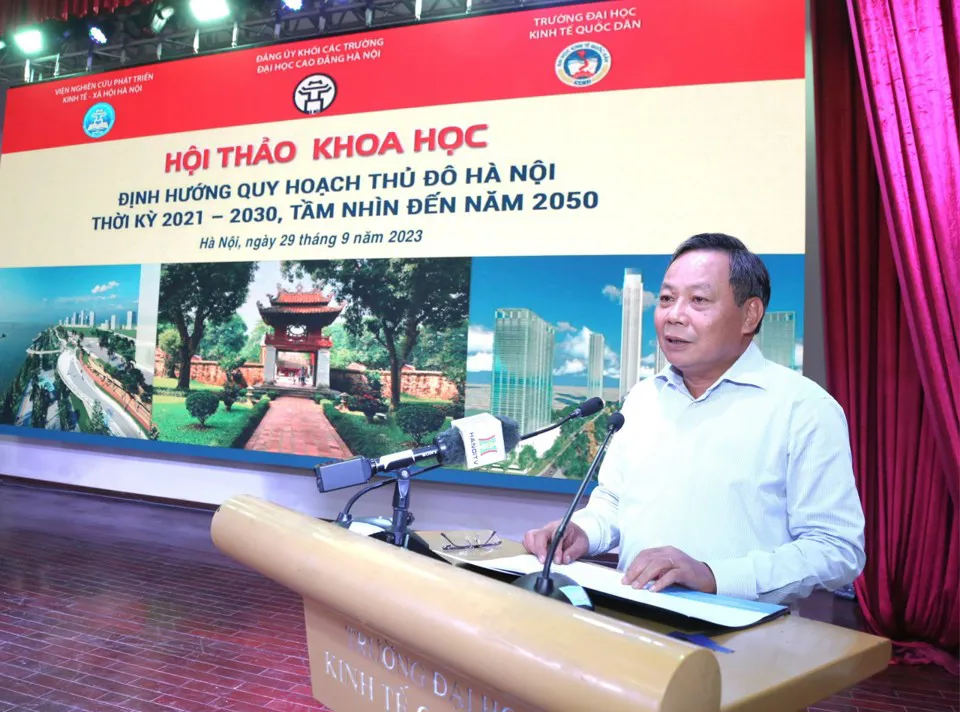Hanoi aspires to become a global city
The formulation of capital planning is an integral component of Hanoi's endeavors to achieve its developmental goals by 2030, with a forward-looking perspective reaching to 2045.
Hanoi commits to transforming into a globally interconnected metropolis by 2045, serving as the country's visage, said Deputy Secretary of the Hanoi Party Committee Nguyen Van Phong at a scientific conference on the Hanoi Planning Orientation for 2021-2030, with a vision to 2050, held today [September 29].
| Overview of the conference. Photos: Thanh Hai/The Hanoi Times |
Phong said the city's goal is not merely to vie for supremacy with other provinces and cities in the country but to position itself globally, comparable to countries in Asia and the world.
During the conference, Deputy Chairman of the Hanoi People's Committee Ha Minh Hai said that the formulation of the capital planning for the 2021-2030 period, with a vision to 2050, is an integral component of Hanoi's endeavors to achieve its developmental goals by 2030, with a forward-looking perspective reaching to 2045.
Hai added that the process of researching and formulating the planning for Hanoi has been monitored by the city's leaders, who have actively instructed the planning agency to host numerous seminars and discussions, actively seeking input from different entities, including agencies, organizations, experts, and scholars.
The conference, led by the Party Committee of Hanoi Universities and Colleges in collaboration with the Hanoi Institute for Socio-Economic Development Studies and the National Economics University, served as a platform to harness the wisdom and enthusiasm of experts, scholars, officials, party members, and educators from universities, institutes, and colleges in shaping the direction of Hanoi's Planning for the period 2021-2030, with a vision to 2050, said Hai.
| Vice Secretary of the Hanoi Party Committee Nguyen Van Phong. |
Simultaneously, he added that the conference aimed to solicit their ideas on solutions, contributing to the economic and social development of the capital and the nation.
Hai noted that more than 60 articles were submitted to the conference, characterized by their diverse, rich, and high-quality content. These articles reflect the extensive knowledge, wisdom, insight, and dedication of scholars and experts to Hanoi, making a substantial contribution to the management and development of Hanoi as a capital, both in general and within the context of the Capital Planning process.
Hoang Van Cuong, Vice President of the National Economics University and representative of the consulting unit responsible for the planning, emphasized that the cultural and civilized aspects of Thang Long - Hanoi are fundamental pillars of Hanoi's development philosophy.
Furthermore, he outlined five perspectives for Hanoi's development, with the foremost being rapid, sustainable, creative, and inclusive growth, aiming to enhance the country's international image and prestige.
In terms of the five breakthrough stages, besides the foundational elements of institutions and governance and the connection of infrastructure and resources, two additional elements were proposed by consulting units: urban and real estate services, as well as environment and landscape. Notably, the draft plan proposed the adoption of Transit-Oriented Development (TOD) urban models in renovation and beautification efforts to cultivate a civilized and contemporary urban aesthetic.
The draft plan presented three economic development scenarios, all underscoring the continued primacy of service development in Hanoi's economic structure.
| Vice Chairman of the Hanoi People's Committee Ha Minh Hai. |
The capital's development was structured around six key pillars: global, cultured, civilized, and modern city; institutional capacity and governance, along with culture and heritage preservation; green urban spaces and a circular economy; modern transportation infrastructure; a smart urban digital society/digital economy, coupled with a focus on science, technology, innovation, and job creation.
Additionally, the draft plan identified five socio-economic regions, five development spaces, and five urban development areas.
The project also put forth five recommendations for implementing the planning. The first recommendation focused on encouraging population redistribution, relocating universities and hospitals to relieve pressure on downtown areas, promoting private and technology-related investment, and instituting mechanisms for agricultural development in the capital, including the utilization of water surfaces and riverbanks.
Following the comprehensive overview of the draft Capital Planning, numerous experts, academics, and university lecturers made presentations and engaged in discussions on various specific topics, including enhancing Hanoi's leadership role, advancing education and training in the capital, strengthening the healthcare system, optimizing agricultural space, developing underground spaces, and integrating culture into urban planning.
In his closing remarks at the conference, Deputy Secretary of the Hanoi Party Committee Nguyen Van Phong highlighted that the discussions at the conference delved into critical matters not limited to Hanoi's internal affairs but also about both immediate and long-term considerations. "The vision went beyond a mere five-year outlook to encompass broader horizons."
Phong emphasized that if Hanoi were to develop a well-thought-out and successful plan, it would play a pivotal role as an engine and driving force, actively contributing to disseminating and leading socio-economic progress in the Northern region, with a particular focus on the Red River Delta region in the years to come.
Moreover, he highlighted a fresh perspective in Capital Planning—the centrality of the Red River as a pivotal landscape axis to guide the capital's development in the forthcoming era. He emphasized the city's concern about harmonizing civilized, modern, and cultural development. The city has borne various roles and responsibilities throughout different historical periods, serving as the country's cultural, political, and economic epicenter. Given this, there are still shortcomings in historical planning that need to be addressed quickly.
"Thus, the contributions made at this conference hold profound and practical significance for the city of Hanoi," he concluded.














